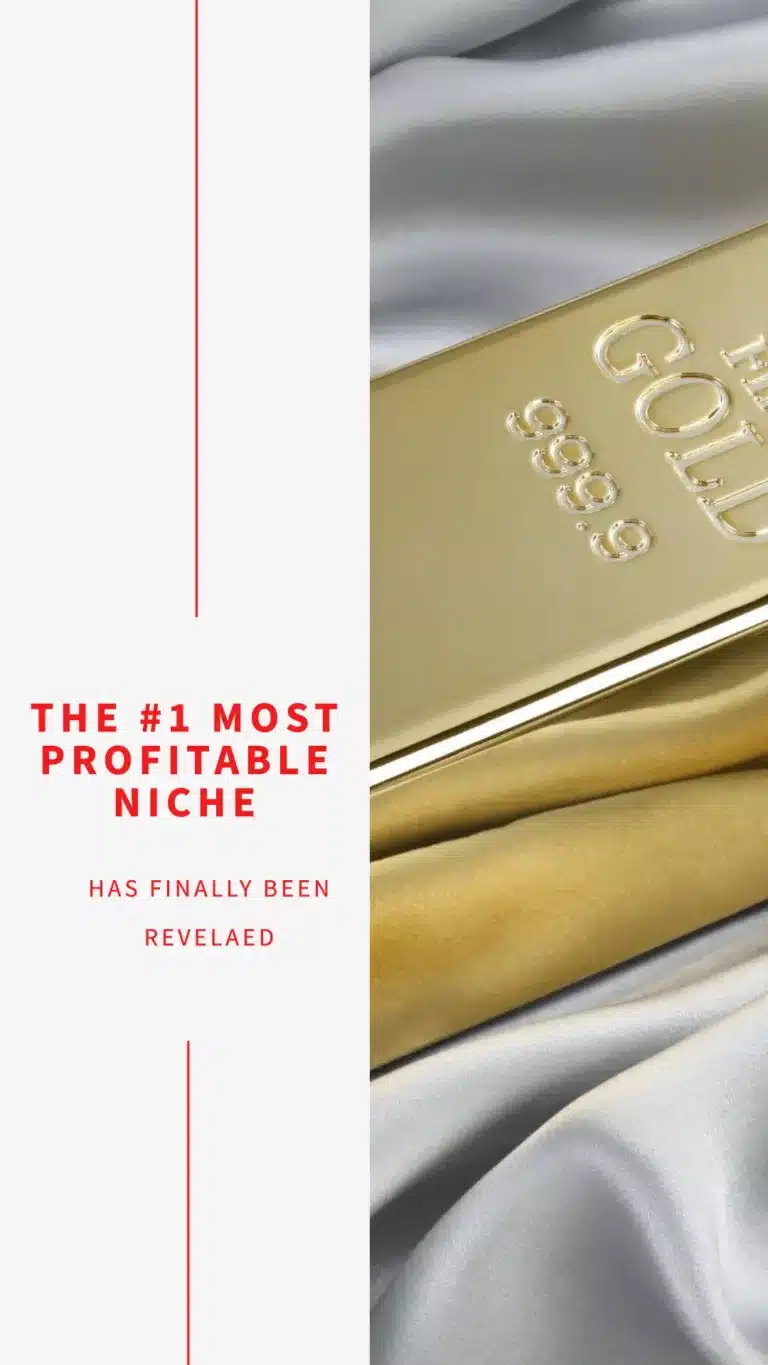Are You Familiar With the Gray Apocalypse in America?
Nearly 80% of Americans live in this “Gray Apocalypse.” While you may not have heard the term before today, you know the symptoms. Your life has become zombie-like. You either go through the motions of working until you can’t, sell all of your worldly possessions to downsize, or find a way to get by. Meaning you do not have enough money for a comfortable retirement.
I am on a mission to prevent the Gray Apocalypse for as many people as possible. Spread the word. There is a way out of this. It all starts with choosing the #1 Most Profitable Niche.
Found! The #1 Most Profitable Niche for Blogging
As a blogger searching for The #1 Most Profitable Niche, I tirelessly scoured posts that led me to believe that making money online was effortless. This constituted the dream of discovering the Holy Grail of Niche Blogging. People everywhere are growing discouraged by the lack of progress in their search. One by one, got started, chose the profitable nice from a list, and eventually strayed away from their promisingly profitable niche. Choices that were never meant for them to begin with. They left blogging forever. Google documents that 95% of all entrants into the Blogosphere fail.

The more I scoured the internet, the more I realized that I had a lot to learn about niche blogging. This was when I found the training at Wealthy Affiliate. Their education program, AI tools, and community support are all first-class. I am a proud member of the Wealthy Affiliate program. When you are ready to beat the Gray Apocalypse on your terms, you will become a member as well. This post contains an open invitation for you to join Wealthy Affiliate, but it is not about that. It is about obtaining the keys to The #1 Most Profitable Niche (for you) to supplement your retirement income and beat the Gray Apocalypse.
My guide will steer you past the pitfalls of picking from the 1001 Perfectly Profitable Passive Niche Income Lists. Do not pick from a stale list of topics that are not you. You are no doubt asking yourself at this point if I am not picking from a “List of Profitable Blog Topics” how am I going to going to find the most profitable niche?
I challenge you to define a profitable niche.
My definition of a profitable niche is simple. A profitable niche makes you money. How does a blog make money? It attracts an audience. How does a blog attract an audience? It stands out. So logic would follow The Most Profitable Blog is the Blog that Stands Out!
What Makes Your Blog Stand Out?
In an ideal world, you would have assessed yourself before embarking on a career in affiliate marketing and the niche blogging arena. If you didn’t, take a moment to be truthful with yourself then, consider your motivations for pursuing this path now.

Did you get into this
to make money?If the answer to this question is YES. You just failed to stand out. You are doomed to failure like the other 95% of people who started in this field. I am sorry.
The Amazing Niche Master
If you are still standing after the last question, you have just peeled away 95% of your competition! We can E-E-A-T away at the next 5%.
Established (E), Expert (E), Authentic (A), and Trustworthy (T)—The E-E-A-T Principles will unlock your blog’s full potential.
The #1 Most Profitable Niche Hides in Plain Sight
During my introduction, I mentioned that the most profitable niche is not listed on any list. Then, I explained that the most profitable niche is the one that stands out from the rest. Lastly, I emphasized that the most profitable niche is not focused on making money. So, have you figured out what the most profitable niche is?
Need inspiration? ChatGPT shines the light in dark places. So I asked, the reply – “The answer to this question will vary depending on your goals, skills, and preferences.” The Holy Grail of Bloggers eludes ChatGPT as well.
Curious yet? One final clue. Are you familiar with the phrase Money Follow Mastery? What have you mastered? Let’s start with your Superpowers – Everyone has a superpower. Mine is helping others to succeed. What makes you unique? What expertise do you possess that brightens the lives of others around you? What talent do your friends or life-long partner tell you that you have? Yes, you could keep it R-rated and still be profitable. All of these questions are leading you to my doorstep.
You will acquire the #1 Most Profitable Niche when you follow The Amazing Niche Master process I developed. Using this persona you will reveal The #1 Most Profitable Niche (for you).
Crafting Content to Convert
Finding the most profitable niche for retirement blogging is only the first step. You also need to create engaging content that attracts, educates, and converts your niche audience. Content is the king of online marketing, and without it, you won’t be able to build trust, authority, and loyalty with your readers.

But where do you find the king of content that stands out from the crowd? How do you ensure your content is relevant, valuable, and optimized for your niche? How do you keep your readers interested and motivated to take action?
To create engaging content for your niche audience, I use three proven strategies: providing value, using data, and applying LSI keywords. These strategies will help you create content that solves your readers’ problems, supports your claims, and boosts your SEO and ranking.
Provides Value by Creating Helpful Guides, Reviews, and Solutions, NOT Promotional Content
The first strategy to create engaging content is to provide value to your readers. Value is what makes your content worth reading, sharing, and acting upon. For example, bookmarking this post. Value is what makes your content stand out from the rest. Did your reader learn something new? That is value.
What do readers find valuable? The key is to focus on helpful guides, reviews, and solutions. What if I gave you a promotional fluff piece? Is there any value to that? Was it helpful? Helpful content is content that addresses pain points, challenges, and goals. Helpful content also offers practical, actionable, and realistic advice that helps your readers achieve their desired goals.
Promotional content, on the other hand, is content that focuses on selling your products or services.

Promotional content solely focuses on highlighting your achievements, emphasizing the excellence of your offers, and insisting that your readers need them. It fails to build trust or provide any compelling reasons for your audience to believe in you.
While promotional content is not bad per se, it should not be the main focus of your content. Use it sparingly and strategically, after you have established a relationship with your readers and provided them with enough value. Promotional content should only be used as a way to support your helpful content, not to replace it. Check out my RESOURCE section.
Why is this important? Because your readers are not stupid. People can easily recognize when someone is trying to sell them something without offering them any real value. They can sense when someone is not genuinely interested in helping them but is solely focused on making money. They can also tell when someone is not being honest, authentic, and trustworthy.
When they sense this, they will lose interest, trust, and respect for you. They will look for someone else who can provide them with the value they are looking for.
So, how do you create helpful content that provides value to your readers?
Here are some tips:
- Identify your readers’ pain points, challenges, and goals. I like to read comments and reviews, on forums like Quora or Reddit to find out what questions or topics are of interest
- Create valuable content that solves readers’ problems, helps them achieve goals, and provides useful resources such as guides, tutorials, checklists, reviews, comparisons, or case studies.
- Ensure that every piece of content you create provides value. Each post you produce should be clear, concise, and easy to understand. Your content must be practical, actionable, and realistic. Additionally, it should be original, unique, and creative. It is up to you to ensure that it is relevant, timely, and updated.
By creating helpful content that provides value to your readers, you will have created engaging content that attracts, educates, and converts your niche audience. You will also build trust, authority, and loyalty with your readers, and eventually, turn them into loyal customers and fans.
Don’t Believe It? Support Your Claims with Facts, Figures, and Statistics
The second strategy to create engaging content is to use data to support your claims. Data is what makes your content credible, reliable, and trustworthy. Data is what makes your content stand out from the rest.

But how do you use data to support your claims? The key is to use facts, figures, and statistics that are relevant, accurate, and authoritative. Facts, figures, and statistics are data that can back up your arguments, opinions, and recommendations.
Why is this important? Because your readers are not gullible. They won’t believe everything you say without any evidence. They won’t trust your claims without any proof. They will doubt your credibility, reliability, and trustworthiness. They will even question your authority, expertise, and authenticity. So get the facts straight.
So, how do you use facts, figures, and statistics to support your claims?
Here are some tips:
- Find data that is relevant to your niche, topic, and audience. You can do this by conducting your research or by using data from reputable sources, such as academic journals, government agencies, industry reports, or authoritative websites. You can also use Google Trends to find data on trends, markets, or demographics related to your niche. Here is the search on Google for my #1 Most Profitable Niche.
- Use data that is accurate and up-to-date. Do not rely solely on the word of ChatGPT. I found an interesting article on Business Insider about the Birth of a New AI Industry – Picking Up After AI
- Provide the links to the sources that you are using. Business Insider
To create compelling content that is convincing, dependable, and trustworthy, you can utilize factual data, figures, and statistics to reinforce your arguments. This approach will also help you to establish a sense of trust, expertise, and faithfulness with your readers, which could eventually lead to them becoming loyal supporters and customers.
Boosting Your SEO and Ranking with Semantic (LSI) Keywords
The third strategy to create engaging content is to apply LSI keywords to boost your SEO and ranking.
I was recently asked, “What is an LSI keyword? I hope it’s something simple.”
My reply – It Is and It Isn’t
Before I answer this, please take a moment to read this for some context. I wrote it for myself a little earlier this year.
Google Hummingbird & SEO – Read Post Google Hummingbird & SEO
For the It Is Simple
Google believes that it is smarter than you are. When you type words in the search bar, it is trying to determine what you are looking for versus looking for those stupid keywords that you either misspelled or typed in half-@$$ed. It used to do this by pulling in words related to what you typed.
DEFINITION BY PERPLEXITY (My AI Assistant Today)
LSI, or Latent Semantic Indexing, keywords are words and phrases that are related to a primary keyword.
They are used to help search engines better understand the context and meaning of a piece of content, and to determine which pages are most relevant to a particular search query. I should have asked Lexi to explain this to a 3rd grader. So I asked for an example.
For example, if the main search word is “apple,” some LSI keywords could be “fruit,” “nutrition,” “orchard,” “healthy snacks,” “dietary fiber,” and “apple varieties“
Now the “It Isn’t Simple” part.
Google has repeatedly said that they no longer use LSI. If that is the case explain this…
Search Google for my blog “Setting Points”
What do you find? Crickets! My blog isn’t anywhere near the top of the list. What is?
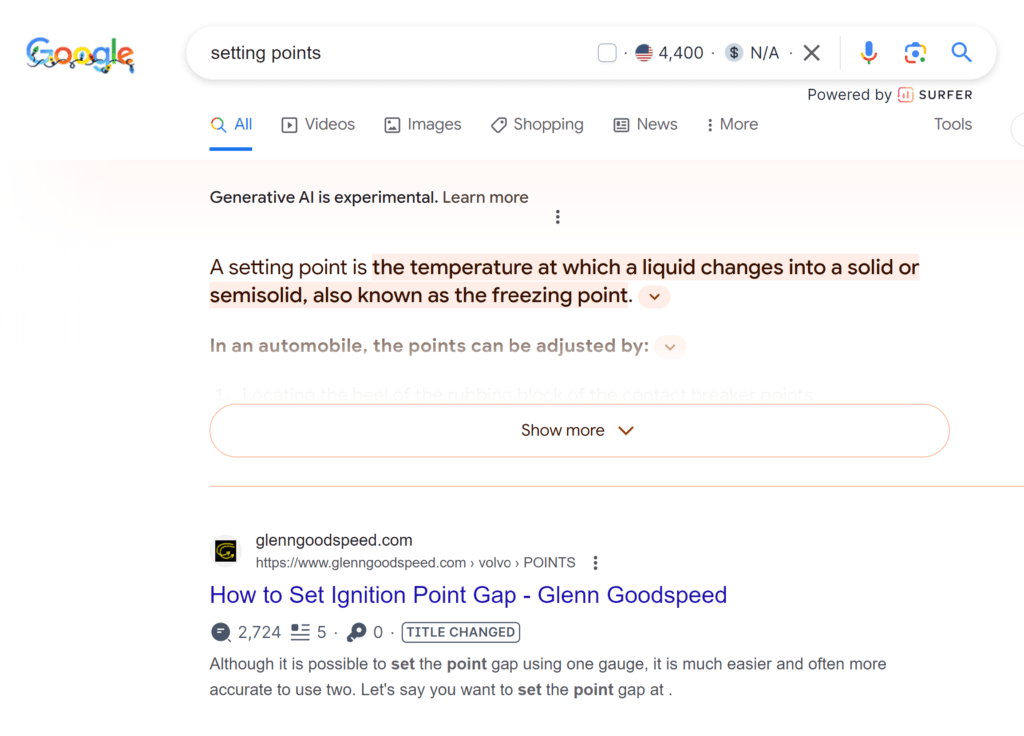
How to Set Ignition Point Gap – Glenn Goodspeed is the top post.
This search result does not contain “Setting Points”! So LSI is obviously “baked” into the SEO framework even though it is no longer called. Google is being mysterious.
So how do you use these non-existent LSI keywords to boost your SEO and ranking? The key is to use LSI keywords that have high search volume and low competition.
Search volume is the number of times a keyword is searched for on Google. Competition is the number of websites that are ranking for that keyword. High search volume and low competition mean that the keyword is popular and easy to rank for.
But why is this important? Because your readers are not psychic. They won’t find your content unless you rank high on Google. How many times have you gone beyond the first page of Google’s search results? I rarely do. Is this a good thing or a bad thing? Try discovering a new up-and-comer next time.
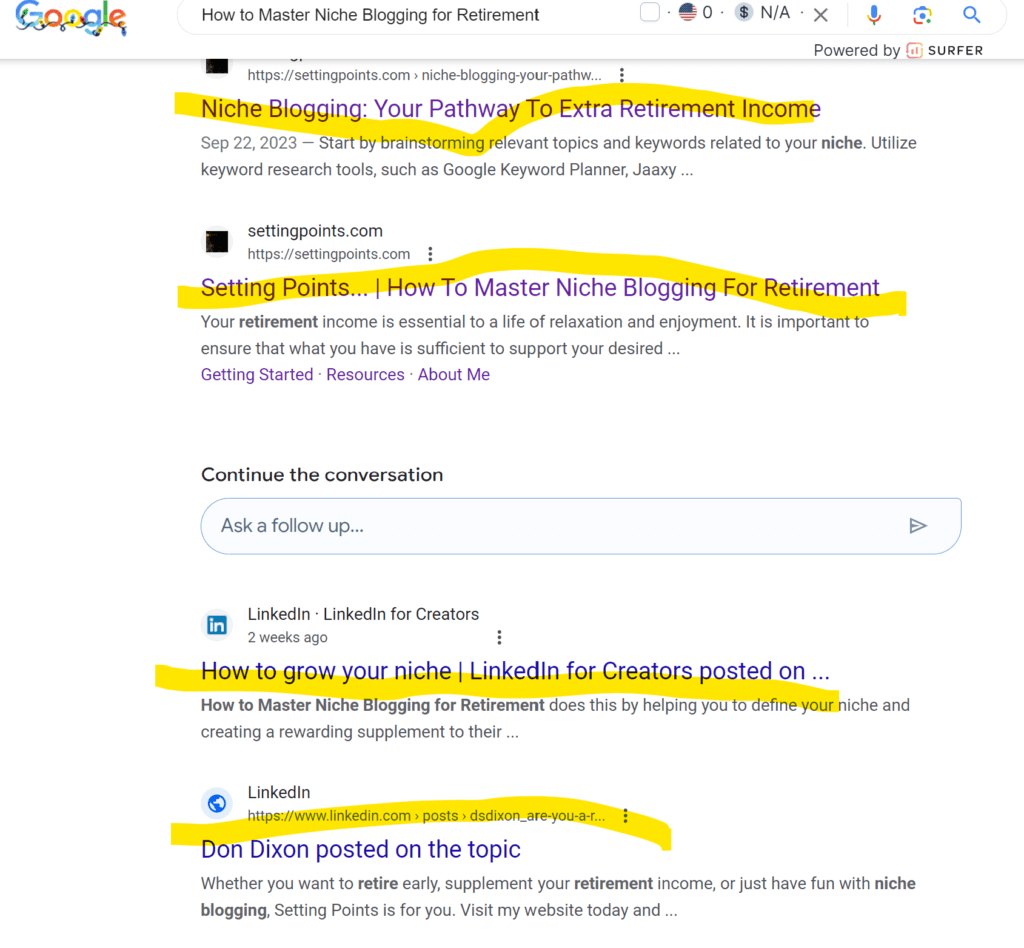
You won’t find Setting Points on Google unless did scroll beyond page one. But as I showed you above when searching for “How to Master Niche Blogging for Retirement” I have 5 of the top 6 spots with the help of the LSI keywords.
Don’t be the unknown soldier toiling away on an unforgiving desolate corner of the web. Get found with the help of LSI. I did!
How do you use LSI keywords to boost your SEO and ranking?
Here are some tips:
- Find LSI keywords that are relevant to your niche, topic, and audience. I use Jaaxy and Ubersuggest, to find LSI keywords that have high search volume and low competition.
- It is important to incorporate LSI keywords throughout your content, specifically in your title, headings, subheadings, introduction, conclusion, and meta tags. However, it’s crucial to do this naturally and organically, without stuffing them. You can also use LSI keywords in various forms such as synonyms, antonyms, variations, or modifiers.
- Optimize your content formatting for readability and engagement. You can do this by using techniques like breaking up your text into short paragraphs, using headings and subheadings, using bullet points or numbered lists, using images or videos, using bold or italic fonts, using quotes or testimonials, etc. You can also use tools like Hemingway or Grammarly to check your grammar,
Crafting Quality Content for Your Niche Audience
As a blogger who is a retiree, soon-to-be retiree, or inspired to retire early, you have a unique opportunity to share your insights, stories, and advice with your audience. But how do you craft quality content that engages and informs your readers, while also showcasing your expertise and authority in your niche? Here are some of the best practices that I follow for creating engaging and informative blog posts. I am always telling a story about my experiences while maintaining E-E-A-T to build authority and carve away at the remaining 5%.
Creating the Most Engaging and Informative Blog Posts Possible
Blog posts are the most common and effective form for retirees to use for niche blogging. They allow you to cover a variety of topics, from financial planning to lifestyle tips, and create value for your readers.

However, not all blog posts are created equal. How many posts have you skipped over for one reason or another? Do not let this happen to you.
To prevent your post from being killed by boredom. here is a quick list of things to consider when you create your post.
- Know Thy Audience. I started with the obvious. Why are you reading this post? What do they want to learn, and how you can help them? Use Google Analytics to learn more about your audience demographics, interests, and preferences.
- Read the Forums. I know that I mentioned earlier that I am on Quora and Reddit. I use them to see what topics and questions are popular and relevant. When I have a post about it, I answer the question and reference back to it.
- Eye Candy. Your title is the first thing that your readers will see. It would help if you made your title catchy, clear, and compelling, while also including your main keyword. Your AI Personal Assistant can create a great title for your post. What is the Title of this post? Do you remember?
- Write a captivating introduction. The Hook grabs their heartstrings, The Line reels them in, and the Sinker wears them out. Your introduction is the second thing that your readers will see, and it will determine whether they keep reading your post or not. You need to make your introduction captivating, concise, and informative, while also hooking your readers’ attention and interest. You can use techniques like starting with a question, a statistic, a quote, a story, or a surprising fact to draw your readers in. You can also use your introduction to summarize the main points and benefits of your post and to include your main keyword.
- Use subheadings and bullet points. Your subheadings and bullet points are the third thing that your readers will see, and they will help them scan and navigate your post. You need to use subheadings and bullet points to organize your content into clear and logical sections, while also highlighting the key points and takeaways of your post. I use Grammarly to check and improve the readability and clarity of my subheadings and bullet points.
- Add images and videos. Every image within every post is an original creation specifically for that spot in my post. Your images and videos are the fourth thing that your readers will see, and they will help them understand and enjoy your post. I use Canva and Microsoft Designer to create and edit images for my blog posts.
- Include a Call To Action (CTA). Your call to action is the last thing that your readers will see, and it will determine whether they bookmark your blog, sign up for your newsletter, make a purchase, or simply move on without doing anything.
By following these best practices, you will be able to create engaging and informative blog posts that provide value to your niche audience, and that rank well on Google.
Incorporating Storytelling with Your Retirement Experiences
Storytelling is one of the most powerful and persuasive ways of communicating with your audience. Stories can capture your readers’ attention, emotions, and imagination, and make your content more memorable and relatable. Stories can also showcase your personality, voice, and style, and make your content more authentic and unique. Stories can also demonstrate your experience, expertise, and authority, and make your content more credible and trustworthy.
As a blogger about to retire, you have a wealth of stories to share with your audience, based on your own life experiences. You can use storytelling to:

- Share Your Journey, from planning to living, and the lessons you learned along the way.
- Share Your Goals, dreams, and aspirations, and how you achieved or are working towards them.
- Share Your Challenges, fears, and struggles, and how you overcame or are coping with them.
- Share Your Successes, joys, and achievements, and how you celebrated or are celebrating them.
- Share Your Tips, advice, and recommendations, and how they helped or are helping you or others.
To incorporate storytelling with your experiences, you need to follow some basic principles, such as:
- Have a clear purpose. Before telling a story, know your purpose, message, and action that match your goals, needs, and topic.
- Have a clear structure. Once you establish a clear purpose, it’s essential to structure your story effectively. This involves defining a clear beginning, middle, and end, along with establishing a solid plot, characters, and setting. Additionally, ensuring a distinct conflict, climax, and resolution is crucial. Furthermore, incorporating a captivating hook, surprising twist, and meaningful takeaway enhances the impact of your story.
- Have a clear voice. To create a compelling story, it’s crucial to develop a distinct voice. Your storytelling should exhibit a clear tone, style, and language that sets it apart. Additionally, infusing your narrative with a unique perspective, emotional depth, and subtle humor can enhance its impact. It’s essential to imbue your story with authenticity, personality, and originality, allowing your audience to forge a strong connection. Cultivating empathy and rapport with your readers further strengthens the bond forged through your writing.
By incorporating storytelling with your retirement experiences, you will be able to create engaging and informative content that resonates with your niche audience, and that builds your authority and trust.
Maintaining E-E-A-T in Content Creation to Build Authority
E-E-A-T, which stands for Experience, Expertise, Authoritativeness, and Trustworthiness, is a framework used by Google to assess the quality of content on websites.
E-E-A-T is an essential aspect of Google’s search algorithm, as it helps determine which websites should rank higher in search results based on the credibility and value of their content. E-E-A-T is especially important for YMYL (Your Money or Your Life) websites, such as retirement blogs, that deal with topics that can affect the health, happiness, or finances of the readers.
As a retirement blogger, you need to maintain E-E-A-T in your content creation, to build authority and trust with your audience and Google. You can do this by:
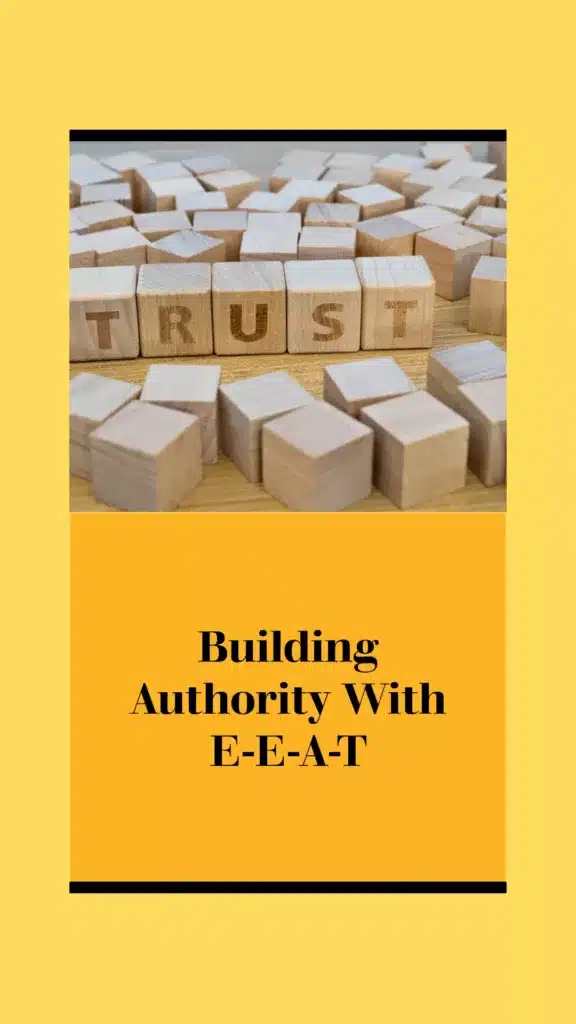
- Demonstrating your experience. You need to show that you have the necessary first-hand or life experience for the topics you write about. You can do this by sharing your personal stories, insights, and lessons learned from your life’s journey. You can also do this by citing relevant data, research, or sources that support your claims and arguments.
- Demonstrating your expertise. You need to show that you have the necessary knowledge and skills for the topics you write about. You can do this by providing helpful, accurate, and comprehensive information that solves your readers’ problems or helps them achieve their goals. You can also do this by displaying your credentials, qualifications, or achievements that prove your expertise and authority in your niche.
- Demonstrating your authoritativeness. You need to show that you have the necessary reputation and recognition for the topics you write about. You can do this by building and maintaining a loyal and engaged audience that trusts and values your content. You can also do this by earning and displaying positive reviews, ratings, testimonials, or endorsements from your readers or other experts in your niche.
- Demonstrating your trustworthiness. You need to show that you have the necessary honesty and integrity for the topics you write about. You can do this by being transparent, consistent, and ethical in your content creation and delivery. You can also do this by protecting your readers’ privacy, security, and safety, and by following the best practices and standards of your niche and industry.
By maintaining E-E-A-T in your content creation, you will be able to create engaging and informative content that builds authority and trust with your niche audience and Google, and that ranks well on search results.
Monetization Strategies for Niche Blogs
If you have a niche blog, you have a valuable opportunity to earn passive income from your content. Monetizing your blog can help you supplement your retirement income, fund your retirement lifestyle, or achieve your retirement goals. It’s important to note that not all monetization strategies work equally well for every niche, audience, and goal. Some methods may require more time, effort, and investment than others. Additionally, some monetization methods may have ethical implications, which can damage your reputation and trust with your audience. Therefore, it’s crucial to choose the right monetization strategy that is ethical, effective, and appropriate for your niche, audience, and goals.
Monetization methods that you can use for your niche blog
- Advertising: This is where you display ads on your blog, such as banner ads, pop-up ads, or video ads, and earn money every time your readers view or click on them. You can use platforms like Google Adsense to display ads on your blog, or you can work with advertisers directly to display sponsored ads on your blog.
- Affiliate Marketing: This is where you promote products or services that are relevant to your niche and audience, and earn a commission every time your readers buy them through your affiliate links. As a member of Amazon Associates, whenever you see the Amazon Link, you will be following my link. Should you purchase on Amazon, I will be compensated for the sale. You will not be charged anything extra. You can use platforms like Amazon Associates or ShareASale to find and join affiliate programs, or you can work with merchants directly to promote their products or services on your blog.
- Online Courses: This is where you create and sell online courses that teach your niche audience something valuable, such as a skill, a hobby, or a solution. You can use platforms like Teachable or Thinkific to create and host your online courses.
- E-books: This is where you write and sell e-books that provide your niche audience with useful information, such as a guide, a report, or a case study. You can use platforms like Amazon Kindle Direct Publishing or Smashwords to publish and distribute your e-books
These are just some of the monetization methods that you can use for your niche blog, but there are many more that you can explore and choose from. The most important thing is to find a monetization method that suits your niche, audience, and goals and provides value to your readers.
Building a Loyal Fan Club Cultivating Community and Engagement
Creating a blog requires more than just writing words. It’s about nurturing a lively community where your readers feel acknowledged, listened to, and connected. It involves turning occasional visitors into devoted fans who eagerly anticipate your next post, share your voice with the world, and support you through thick and thin. However, developing such a dedicated readership demands intentional effort in fostering engagement, building community, and consistently delivering what your audience desires while measuring your progress.
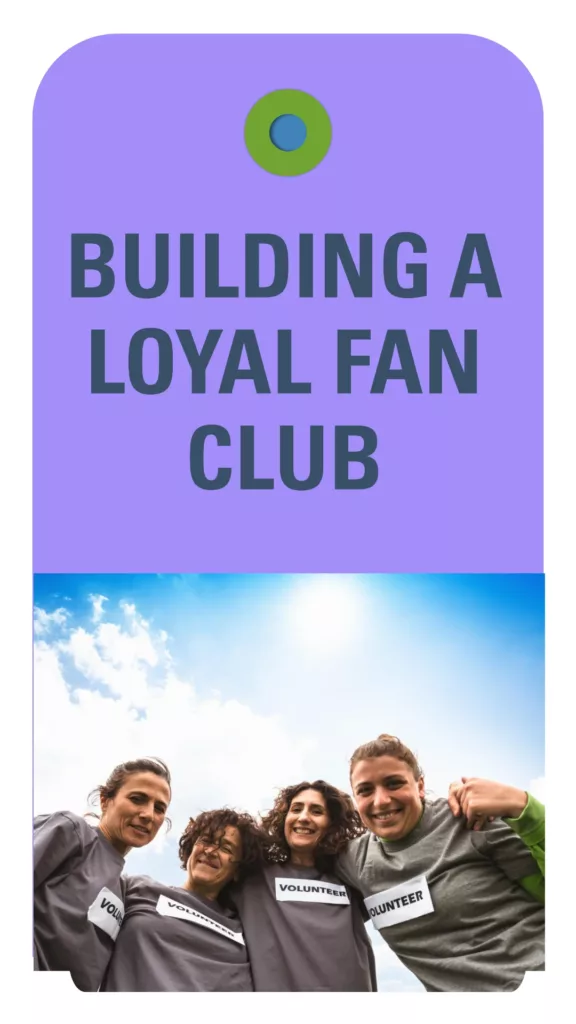
Constructing the Castle Walls
Imagine your blog as a bustling medieval town square. You, the charismatic storyteller, occupy the central platform, you need loyal residents. This is where community building comes in. It’s about crafting spaces where your readers can not only interact with you but also with each other. Consider these avenues:
- Comment sections: Encourage lively discussions by responding to comments thoughtfully, posing open-ended questions, and acknowledging diverse perspectives.
- Forum or Facebook group: Create a dedicated space for deeper, longer-form conversations and knowledge sharing. Host Q&A sessions, run book clubs on relevant topics, or organize online challenges to get the community buzzing.
- Collaborations: Partner with other bloggers or influencers in your niche to host joint webinars, guest posts, or even live chats. This broadens your reach and exposes your community to new voices and perspectives.
Keeping the Fire Burning Everywhere
Engagement is the oxygen that keeps your community alive. It’s the back-and-forth conversation, the shared laughter, and the heated debates that make your readers feel invested. Go beyond the blog and diversify your engagement avenues:
- Social media: Master the art of platform-specific engagement. Share snippets of your blog posts, answer questions in real-time, run polls and quizzes, and even host Twitter threads on thought-provoking topics.
- Email marketing: Craft captivating newsletters that offer exclusive content, behind-the-scenes glimpses, and personalized recommendations. Keep your tone conversational and avoid sounding too promotional.
- Interactive content: Spice up your blog with quizzes, polls, surveys, and even interactive infographics. Give your readers a platform to voice their opinions and actively participate in shaping your content.
Analyzing Success and Adapting Strategies
Building a loyal readership, like blogging itself, is a continuous journey, not a destination. Keep a close eye on metrics such as comment engagement, social media mentions, email open rates, and website traffic to gain insights into your audience’s preferences. Embrace the opportunity to experiment with various formats, themes, and engagement strategies.
Beyond the Buzzwords
Notice the deliberate absence of overused, clickbait-y verbs in this section. While exciting vocabulary has its place, true engagement comes from substance and authenticity. Your readers, especially those seasoned in the blogging world, are discerning individuals who value honest, informative content above all else. Focus on delivering meaningful insights, fostering genuine connections, and providing value. That’s the recipe for building a loyal readership that sticks around, not just for the next post, but for the long haul.
Fueling Your Retirement Dreams
As our journey exploring niche blogging’s #1 Most Profitable Niche draws to a close, I hope I’ve inspired you to rediscover the magic within your own story. The opportunity to supplement your retirement income lies within your passions, experiences, and talents.
Each post you write refines your authentic voice and deepens your bond with a community interested in your guidance. What sweeter reward in retirement is there than each new day offering more chances to connect with people and feel needed?
From this day forward, I encourage you to share your experiences with courage and compassion. Continue the journey with no destination, listen intently to a grateful audience, and lead this generation to see your truth. In doing so, your words may awaken slumbering dreams or mend weary souls in need of respite.
Stay anchored in your purpose and mastery, money and blessings will follow. The choice is yours – will you accept retirement’s summons to greatness? I believe in your power to transform lives through your gift. Now it’s time to believe in yourself.
Are you ready to follow Setting Points and eliminate the Gray Apocalypse? Put your plans in motion by starting your blog today with Wealthy Affiliate. Their all-inclusive platform provides everything you need to succeed, from website building to step-by-step training. Learn more and kickstart your journey using the link below!


